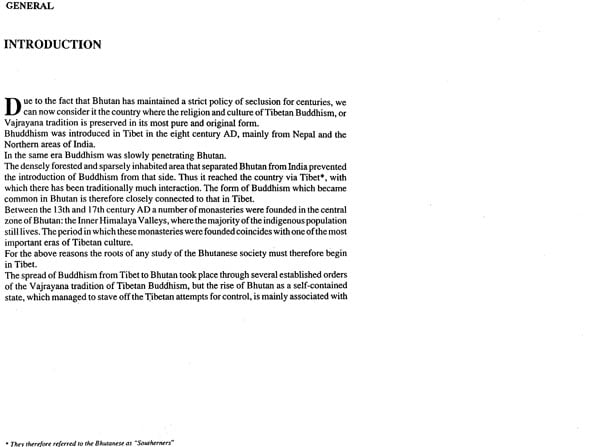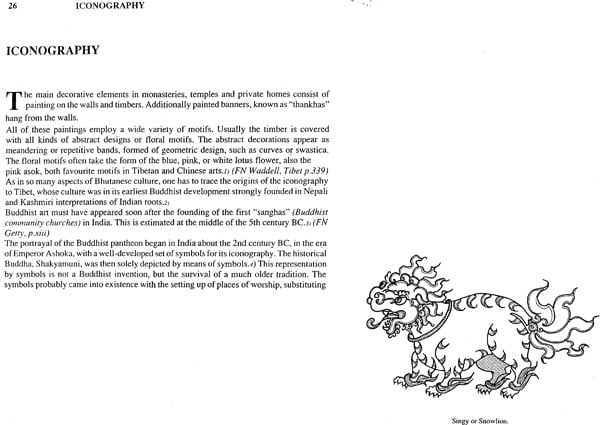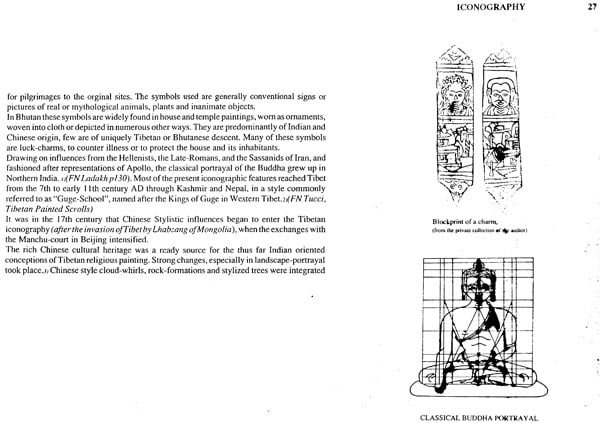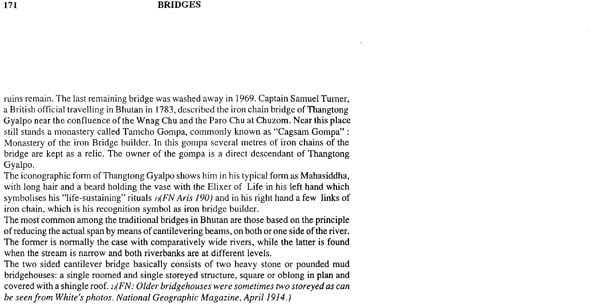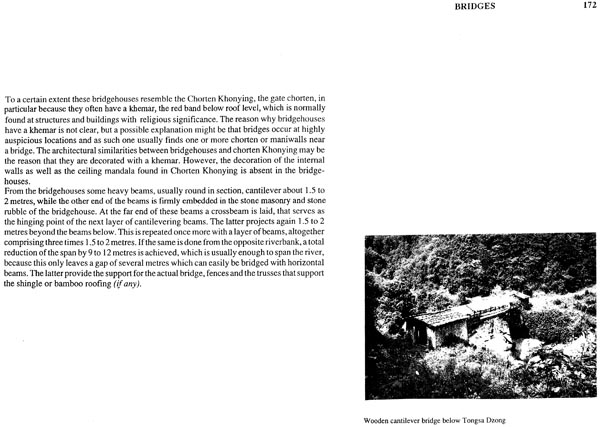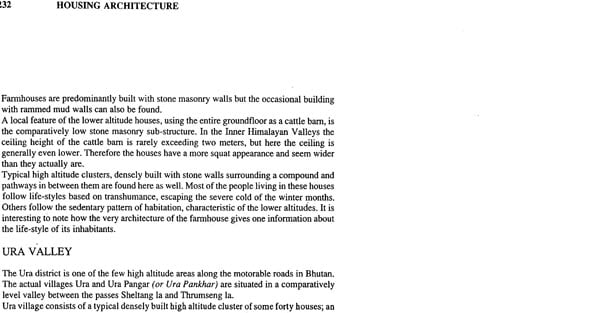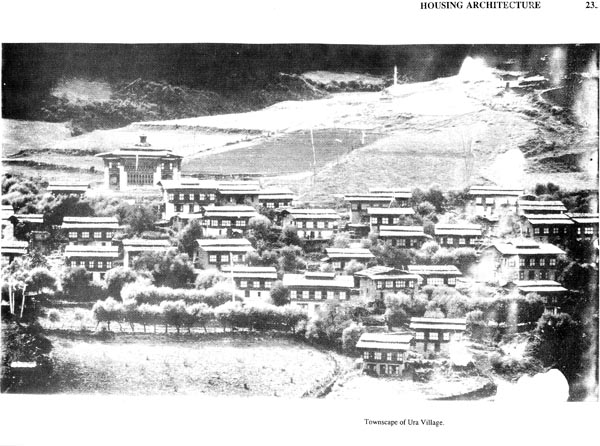
An Introduction to Traditional Architecture of Bhutan
Book Specification
| Item Code: | NAO697 |
| Publisher: | Department of Works, Housing and Roads Royal Government of Bhutan |
| Language: | English |
| Edition: | 1993 |
| Pages: | 276 (Throughout B/W Illustrations) |
| Cover: | Hardcover |
| Other Details | 11.0 inch X 8.0 inch |
| Weight | 1 kg |
Book Description
The late King of Bhutan, His Majesty Jigme Dorji Wangchuck, and the late Prime Minister of Bhutan, Lonchen Jigme Palden Dorji, were the two main architects of modern Bhutan. The former was a thinker, innovator and visionary whose ideas were far ahead of his times. He was a wise and benevolent ruler who strengthened the kingdom's sovereignty and independence by leading Bhutan into the United Nations and other international organizations. He carried out sweeping social, economic and political reforms, and in the process built institutions to promote the peace, stability, unity and prosperity of the kingdom. He was loved and worshipped by his people to an extent rare in world history.
The late Prime Minister, Lonchen Jigme Palden Dorji, was totally devoted to his King and country. He shared in his monarch's vision of a new and resurgent nation taking its rightful place in the comity of nations. He realized that unless Bhutan modernized and opened its doors to the outside world, it could not survive as an independent entity in the changed geo-political environment in which the kingdom found itself in the second half of the 20th century. Both the late king and the late Prime Minister were great men who left an indelible impress on Bhutanese history.
His Majesty Jigme Singye Wangchuck, King of Bhutan, on whose illustrious shoulders the mantle of his late father has fallen, has taken bold and courageous steps to consolidate the kingdom's political and cultural identity. Material progress is now not being promoted at the cost of traditional values and culture, and every effort is being made to preserve the kingdom's distinctive identity.
In 1982, by Royal Command, I was given the additional responsibility of urban planning and development, with the specific mandate to preserve the unique architectural heritage of the kingdom. This heritage at that time was in serious danger of being eroded with the import of cement and steel and architectural concepts alien to the kingdom's culture and natural environment.
Bhutanese architects were great innovators. They built massive dzongs without any drawings and without using nails. Every dzong, temple and monastery they built were different. Each were designed to meet different conditions of site, function, and its own time. Judged by any standard, traditional structures such as Tongsa Dzong, Gangtey Gompa and Paro Taktsang are architectural masterpieces. Bhutanese architects have traditionally borrowed architectural forms and ideas from outside and made them their own. Their forms have changed over time, as it must in all living cultures. They developed distinctive ideas through a synthesis of old forms and ideas. Traditional buildings have imbibed ideas from Chinese decorative concepts, Indian religious motifs and Persian window forms. The achievement has been to combine external motifs and make them distinctively Bhutanese. In endeavors to preserve the spirit of traditional architecture, it must be kept in mind that when a culture's forms become frozen and rigid and unchanging, they lost life and freshness. Traditional architecture in order to retain its power and beauty must adjust to changing needs and conditions. It cannot simply clothe new functions with a veneer of old forms. The aims must be to produce structures which blend and mix the best of different ideas and forms and reach a new synthesis.
The aim of this book is to document traditional architecture, both religious and secular. I sincerely hope that this exhaustive documentation of an important facet of Bhutanese culture will serve both as a record of past achievements and as a guide and encouragement to future creativity.
I humbly dedicate this work to our late beloved King, His Majesty Jigme Dorji Wangchuck, and our late beloved Prime Minister, Lonchen Jigme Palden Dorji, for the outstanding leadership they provided in building a new and progressive Bhutan on the bed-rock of the kingdom's rich spiritual and cultural heritage.
Contents
| General | 0 |
| Introdution | 1 |
| Delvelopment of Buddhism into Vajrayana | 3 |
| The Early Era | 9 |
| The Medieval Era | 12 |
| Modern Vajrayona | 14 |
| History | |
| Proto and Ancient Bhutan | 15 |
| The First Spreading of Bhuddhism | 15 |
| The second spreading of Buddhism | 16 |
| The Rice of the Shabdrungs | 20 |
| Establishment of the Hereditary Monarchy | 22 |
| Iconography | |
| Iconography | 26 |
| Key to Vajrayan Iconography | 29 |
| Painting Techniques | 38 |
| Establishment Groupings | 42 |
| Support, rTon | 42 |
| Classification according to Subject | 43 |
| Classification according to composition | 45 |
| Dzongs | |
| Dzongs | 52 |
| Simtokha Dzongs | 63 |
| Tongsa Dzong | 69 |
| Jakar Yugyel Dzong | 72 |
| Wangduchholing Dzong | 76 |
| Druk Punthang Dhechen Phodrang | 79 |
| Tashichho Dzong | 84 |
| Rinchenpung Dzong | 90 |
| Monateries and Temples | |
| Monasteries and Temples | 95 |
| Tamzhing Lhungrub Chholing | 106 |
| Tango Monastery | 110 |
| Dechenphug | 112 |
| Kyichu Lhakhang | 116 |
| Dumtse Lhakhang | 119 |
| Konchogsum Lhakhang | 124 |
| Constructing a Temple | 128 |
| Selection of the Site | 129 |
| Layout and digging of the foundation trench | 132 |
| Erection of the super-structure | 132 |
| Erection of the timbre columns | 133 |
| Construction of the timber floors | 135 |
| The internal plastering | 135 |
| The Internal decorating | 135 |
| Chorten | |
| Chorten | 144 |
| The eight classical chorten | 152 |
| The Chorten Khonying | 155 |
| The mani chukhor chorten | 155 |
| The tashi gomang | 158 |
| The Maniwall or Mendong | 160 |
| Constructing a Chorten | 161 |
| Bridges | |
| Bridges | 169 |
| Housing Architecture | |
| The Country and its People | 180 |
| The People | 182 |
| Settlement Patterns | 183 |
| Rural settelments | 188 |
| Housing Architecture | 191 |
| The archetype Inner Himalayan | 191 |
| Valley framhouse | |
| Foundations | 191 |
| Walls | 193 |
| Standard roof patterns | 196 |
| Inner structure | 200 |
| Entrances and balconies | 202 |
| Ground floor | 203 |
| First floor | 204 |
| Second floor | 204 |
| Attic | 205 |
| External decorations | 206 |
| High Altitude Architecture Regional, Differences in Housing Architecture | 209 |
| Haa Valley | 219 |
| Paro Valley | 219 |
| Punakha area | 220 |
| Wangdi Phodrang area | 222 |
| Tongsa area | 226 |
| Bumthang Valleys | 226 |
| Ura Valley | 230 |
| Mongar area | 232 |
| Tashing area | 238 |
| Tashing town | 241 |
| Thimphu Valley | 243 |
| New Trends in Building Materials | 244 |
| And Construction Techniques | 245 |
| Appendices | |
| Appendix | 248 |
| Appendix | 250 |
| Appendix | 252 |
Sample Pages
